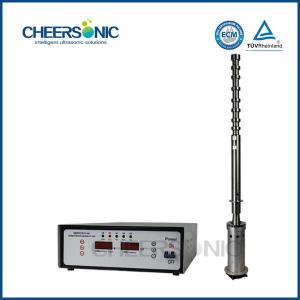Supplier: Cheersonic Ultrasonics Co.,Limited
Contact person: Ms. Xia Lee
Position:
Address: Gaoqiao Industrial Zone, Fuyang,Zhejiang,China
Country: China
Phone: 86 571 89710406 - Mobi: 13588732518
ultrasonic sonochemistry
Price:
1. Upon irradiation with high intensity sound or ultrasound, acoustic cavitation usually occurs. Cavitation – the f-
ormation, growth, and implosive collapse of bubbles irradiated with sound — is the impetus for sonochemistry
and sonoluminescence. Bubble collapse in liquids produces enormous amounts of energy from the conversio-
n of kinetic energy of the liquid motion into heating the contents of the bubble. The compression of the bubbles
during cavitation is more rapid than thermal transport, which generates a short-lived localized hot-spot.
2. Sonochemical reaction is an attractive method for preparing novel materials with unusual properties. The a-
dvantages of using sonochemical methods for sample preparation include high purity, narrow size distributions,
controllable reaction conditions and the ability to form nanoparticles with uniform shapes and rapid reaction rate.
It also improves the performance of phase transfer catalysts and reactivity of catalysts or reagents.
3. Ultrasonic mixing equipment is widely used in cosmetic industry for producing, degassing and homogenizin-
g of emulsions.Ultrasonic devices are used for extracting algae oil and other compounds from the continuous a-
lgae reactors. They are also employed in dispersing and reducing the size of pigments in printing inks and inkj-
et inks.
ormation, growth, and implosive collapse of bubbles irradiated with sound — is the impetus for sonochemistry
and sonoluminescence. Bubble collapse in liquids produces enormous amounts of energy from the conversio-
n of kinetic energy of the liquid motion into heating the contents of the bubble. The compression of the bubbles
during cavitation is more rapid than thermal transport, which generates a short-lived localized hot-spot.
2. Sonochemical reaction is an attractive method for preparing novel materials with unusual properties. The a-
dvantages of using sonochemical methods for sample preparation include high purity, narrow size distributions,
controllable reaction conditions and the ability to form nanoparticles with uniform shapes and rapid reaction rate.
It also improves the performance of phase transfer catalysts and reactivity of catalysts or reagents.
3. Ultrasonic mixing equipment is widely used in cosmetic industry for producing, degassing and homogenizin-
g of emulsions.Ultrasonic devices are used for extracting algae oil and other compounds from the continuous a-
lgae reactors. They are also employed in dispersing and reducing the size of pigments in printing inks and inkj-
et inks.
SEND INQUIRY
Please fill in fully your information to send email
CATEGORY














 Agriculture
Agriculture